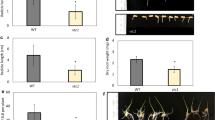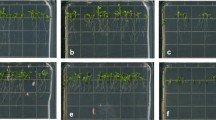Abstract
Ascorbate levels and redox states, as well as the activities of the enzymes of ascorbate metabolism, were analyzed in roots of tomato seedlings during the culture on a medium supplemented with auxin and compared to the control cultured on an auxin-free medium. Biochemical parameters were determined separately in the distal part of the root where the inhibitory effect of auxin on root elongation growth is observed and in the proximal half on the organ which reacts to auxin treatment with increased lateral root proliferation. ASC peroxidase activity was found to be stimulated by auxin treatment in the lateral-root forming part of the root. This effect was not observed in the distal part of the organ. On the other hand, ASC oxidase activity was raised by auxin exclusively in the distal part of the root. An inhibitory effect of auxin supplementation to the medium on ASC—reducing enzymes was observed. The dehydroascorbate reductase activity was found to be inhibited by auxin only in the proximal part, while the activity of monodehydroascorbate reductase in both, the proximal and distal parts of the root. Ascorbate content increased in roots during culture irrespective of the presence of auxin. However, auxin treatment resulted in higher DHA levels and more significant participation of DHA in the total ascorbate pool when compared to the control grown on the auxin-free medium. Similar to auxin, adding DHA to the culture medium stimulated lateral root formation and inhibited primary root elongation. In contrast to DHA, ASC treatment affected significantly neither lateral root formation nor primary root growth and partly reversed the stimulatory effect of IAA on root formation and the inhibitory effect on root elongation. These results suggest that auxin induced changes in ascorbate metabolism may be involved in developmental reactions in tomato roots.









Similar content being viewed by others
Abbreviations
- AFR:
-
Ascorbate free radical
- AFRR:
-
Ascorbate free radical reductase
- AOX:
-
Ascorbate oxidase
- APX:
-
Ascorbate peroxidase
- ASC:
-
Ascorbic acid
- DHA:
-
Dehydroascorbate
- DHR:
-
Dehydroascorbate reductase
- IAA:
-
Indoletriacetic acid
References
Arrigoni O, Chinni E, Ciraci S, De Tullio MC (2003) In vivo elicitation of ascorbate oxidase activity by dioxygen and its possible role in photosynthesizing leaves. Rend Fis Acc Lincei 14:127–134
Bhalerao RP, Eklöf J, Ljung K, Marchant A, Bennett M, Sandberg G (2002) Shoot-derived auxin is essential for early lateral root emergence in Arabidopsis seedlings. Plant J 29:325–332
Bradford MM (1976) A rapid and sensitive method for the quantitation of microgram quantities of protein utilizing the principle of protein dye binding. Anal Biochem 72:248–245
Casimiro I, Marchant A, Bhalerao RP, Beeckman T, Dhooge S, Swarup R, Graham N, Inzé D, Sandberg G, Casero PJ, Bennett M (2001) Auxin transport promotes Arabidopsis lateral root initiation. Plant Cell 13:843–852
Chen GX, Asada K (1989) Ascorbate peroxidase in tea leaves: occurrence of two izozymes and the differences in their enzymatic and molecular properties. Plant Cell Physiol 30:987–998
Cleland RE (2004) Auxin and cell elongation. In: Davies PJ (ed) Plant hormones. Biosynthesis, signal transduction, action. Kluwer Academic Publishers, Dordrecht, Boston, London, pp 204–220
De Gara L, Paciolla C, De Tullio MC, Motto M, Arrigoni O (2000) Ascorbate dependent hydrogen peroxide detoxification and ascorbate regeneration during germination of a highly productive maize hybrid: Evidence of an improved detoxification mechanism against reactive oxygen species. Physiol Plant 109:7–13
De Tullio MC, Ciraci S, Liso R, Arrigoni O (2007) Ascorbic acid oxidase is dynamically regulated by light and oxygen. A tool for oxygen management in plants? J Plant Physiol 164:39–46
Dubrovsky JG, Rost TL, Colón-Carmona A, Doerner P (2001) Early primordium morphogenesis during lateral root initiation in Arabidopsis thaliana. Planta 214:30–36
Esaka M, Fujisawa K, Goto M, Kisu Y (1992) Regulation of ascorbate oxidase expression by auxine and copper. Plant Physiol 100:231–237
Gadea J, Conejero V, Vera P (1999) Developmental regulation of a cytosolic ascorbate peroxidase gene from tomato plants. Mol Gen Genet 262:212–219
Green MA, Fry SC (2005) Apoplastic degradation of ascorbate: novel enzymes and metabolites permeating the plant cell wall. Plant Biosyst 139:2–7
Jiang K, Feldman LJ (2003) Root meristem establishement and maitenance: the role of auxin. J Plant Growth Regul 21:432–440
Jiang K, Meng YL, Feldman LJ (2003) Quiescent center formation in maize roots is associated with an auxin-regulated oxidizing environment. Development 130:1429–1438
Kato N, Esaka M (1999) Changes in ascorbate oxidase gene expression and ascorbate levels in cell division and cell elongation in tobacco cells. Physiol Plant 105:321–329
Kerk NM, Feldman LJ (1995) A biochemical model for the initiation and the maitenance of the quiescent center: implications for organization of root meristems. Development 121:2825–2833
Kerk NM, Jiang K, Feldman LJ (2000) Auxine metabolism in the root distal meristem. Plant Physiol 112:925–932
Laemmli UK (1970) Cleavage of structural proteins during the assembly of the head of bacteriophage T4. Nature 227:680–685
Laskowski MJ, Williams ME, Nusbaum C, Sussex IM (1995) Formation of lateral root meristems is a two-stage process. Development 121:3303–3310
Lin LS, Varner JE (1991) Expression of ascorbic acid oxidase in zucchini squash (Cucurbita pepo L.). Plant Physiol 96:159–165
Liso R, De Tullio MC, Ciraci S, Balestrini R, La Rocca N, Bruno L, Chiappetta A, Bitonti MB, Bonfante P, Arrigoni O (2004) Localization of ascorbic acid, ascorbic acid oxidase, and glutathione in roots of Cucurbita maxima L. J Exp Bot 55:2589–2597
Mittler R, Zilinskas BA (1993) Detection of ascorbate peroxidase activity in native gels by inhibition of the ascorbate dependent reduction of nitroblue tetrazolium. Anal Biochem 212:540–546
Mulkey TJ, Kuzmanoff KM, Evans ML (1982) Promotion of growth and shift in the auxin dose/response relationship in maize roots treated with the ethylene biosynthesis inhibitors aminoethoxyvinylglycine and cobalt. Plant Sci Lett 25:43–48
Murashige T, Skoog F (1962) A revised medium for rapid growth and bioassays with tobacco tissue culture. Physiol Plant 15:437–497
Oberbacher MF, Vines HM (1963) Spectrophotometric assay of ascorbic acid oxidase. Nature. 197:1203–1204
Omaye ST, Turnbull JD, Sauberlich HE (1979) Selected methods for the determination of ascorbic acid in animal cells, tissues and fluids. Meth Enzymol 62:3–11
Pignocchi C, Flether JM, Wilkinson JE, Barnes JD, Foyer CH (2003) The function of ascorbate oxidase in tobacco. Plant Physiol 132:1631–1641
Rao MV, Paliyath G, Ormrod DP (1998) Ultraviolet-B- and ozone-induced biochemical changes in antioxidant enzymes of Arabidopsis thaliana. Plant Physiol 110:125–136
Sanmartin M, Drogoudi PD, Lyons T, Pateraki I, Barnes J, Kanellis AK (2003) Over-expression of ascorbate oxidase in the apoplast of transgenic tobacco results in altered ascorbate and glutathione redox states and increased sensitivity to ozone. Planta 216:918–928
Stahl RL, Liebes LF, Farber CM, Silber R (1983) A spectrophotometric assay for dehydroascorbate reductase. Anal Biochem 131:341–344
Tanimoto E (2005) Regulation of root growth by plant hormones—roles for auxin and gibberellin. Critical Rev Plant Sci 24:249–265
Tyburski J, Jasionowicz P, Tretyn A (2006) The effects of ascorbate on root regeneration in seedling cuttings of tomato. Plant Growth Regul 48:157–173
Wells WW, Xu DP, Washburn MP (1995) Glutathione: dehydroascorbate oxidoreductases. Meth Enzymol 144:31–33
Acknowledgements
This work was financially supported by the Grant of the Polish State Committee for Scientific Research (Grant No. 2 P04C 068 26).
Author information
Authors and Affiliations
Corresponding author
Rights and permissions
About this article
Cite this article
Tyburski, J., Krzemiński, Ł. & Tretyn, A. Exogenous auxin affects ascorbate metabolism in roots of tomato seedlings. Plant Growth Regul 54, 203–215 (2008). https://doi.org/10.1007/s10725-007-9241-8
Received:
Accepted:
Published:
Issue Date:
DOI: https://doi.org/10.1007/s10725-007-9241-8




